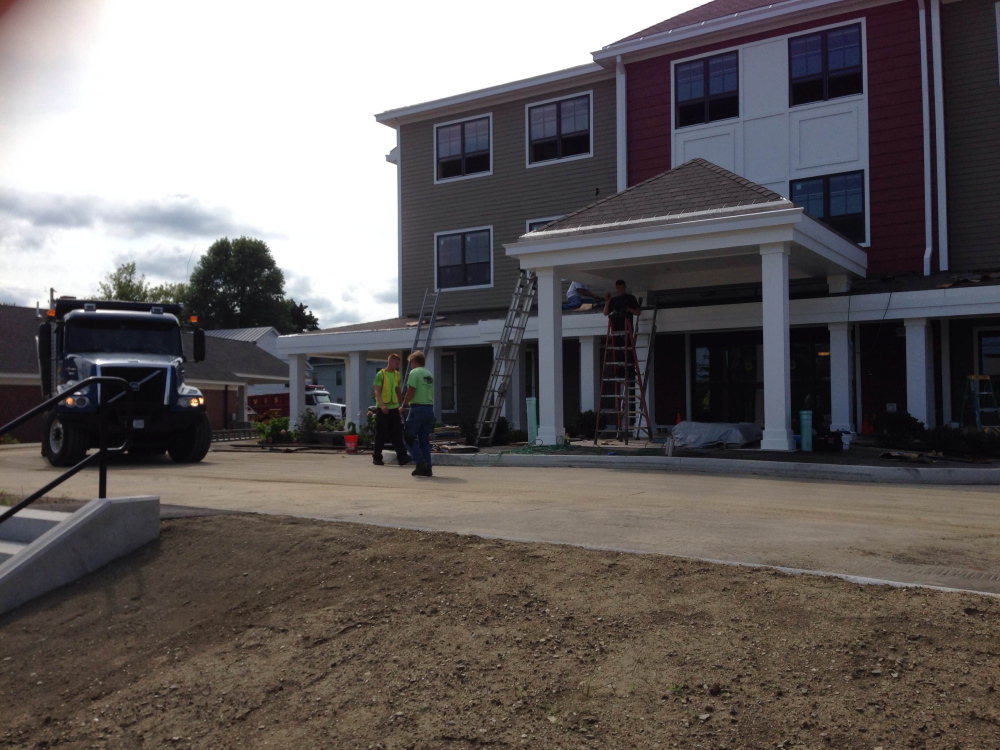WATERVILLE — A Portland developer is asking the city for help to build the next phase of the low-income senior housing apartment complex being built on the site of the former St. Francis Church on Elm Street.
But some city officials questioned whether Waterville needs more subsidized housing.
Crews from Dicon, a construction company owned by the Roman Catholic Diocese of Portland, are completing the 40-unit first part of the two-phase St. Francis Apartments at 52 Elm St. When finished, the apartments will be open to people 62 years of age and older who qualify under U.S. Department of Housing and Urban Development standards.
On Tuesday, a representative from Developers Collaborative met with the city’s tax increment financing district advisory committee to ask for a new TIF district in the area around the complex so the second phase can be built.
Developers Collaborative wants to build an additional 18 units. The development was approved by the planning board for 58 units.
“I don’t presume to say if you think this is something that should or shouldn’t be built, but I think without this, without the support of the city, the chances of it getting built are not too great,” said Kevin Bunker, co-founder of Developers Collaborative, in a meeting with the city’s TIF Advisory Committee on Tuesday.
A TIF district allows a city or town to keep some of the property tax revenue generated by projects within a specific area. It is often used for redevelopment, capitalizing on improvements that increase surrounding property values, using the increased tax revenue to encourage additional improvements.
Without the TIF, it is unlikely the group will be able to arrange financing for the additional 18 units, Bunker said. The first part of the project was completed with federal financing that is no longer available.
While 58 units were approved by the planning board, some officials at the meeting questioned whether the city needs more subsidized housing and brought up concerns on the part of city landlords who have said that subsidized housing has hurt the market.
“We have heard from landlords that there is concern over creating more subsidized housing because they can’t afford to invest in their buildings in order to compete,” said City Councilor Erik Thomas, Ward 4, a member of the advisory committee.
In 2010 Developers Collaborative opened Gilman Place, a $1 million renovation of a former school building on Gilman Street into a 35-unit low-income housing building. City Manager Michael Roy called the project “one of the three best things to happen in the city in the last 10 years” on Tuesday, though he also questioned whether the city needs additional subsidized housing.
But Bunker said the creation of new housing may mean improvements to existing apartment housing.
“It may be good to introduce competition,” said Bunker. “A lot of problems I see in cities are related to the fact that landlords have no economic incentive to invest in their buildings.”
Also on Tuesday, the committee discussed a possible TIF district around Trafton Road near the Waterville-Sidney border. Rhode Island-based Trafton Realty is proposing an Interstate 95 interchange to the road, which is around mile 120 of I-95. The company owns about 900 acres in the area.
If the project goes through, it is likely that the city would have to contribute to upgrades of Trafton Road, which could be financed through creation of a TIF district, according to Roy. The cost of the improvements is estimated to be $1 million, with the Maine Department of Transportation financing half of the project, although the city would also be expected to enter into a three-way agreement with Trafton and the state to pay one-third of the project cost.
Construction of the interchange could begin in 2015, following the completion of an environmental assessment by the Maine Department of Transportation. Officials from Trafton reiterated Tuesday that they are looking for a financial commitment from the city along with the creation of a TIF district. The request comes after a May public hearing in which Trafton Road residents expressed concern over increased traffic and noise as a result of the new interchange.
“What we want to know is that the city is open to the project and is going to be a partner with us,” said John Melrose, a consultant on the project. He said Trafton has been in discussions with some of the property owners in the area as well as Kennebec Messalonskee Trails about land use.
There are two limits in state law regarding TIF districts — a municipality is not allowed to exceed five percent of its total land acreage or total property valuation in TIF districts. The city is not in danger of exceeding either, said Roy.
“Neither project represents a threat to those limits,” he said.
The committee is scheduled to meet again at 4 p.m. on Tuesday, Aug. 19, to decide whether to recommend the TIF proposals to the City Council which must give its approval.
Rachel Ohm — 612-2368
Copy the Story LinkSend questions/comments to the editors.




Success. Please wait for the page to reload. If the page does not reload within 5 seconds, please refresh the page.
Enter your email and password to access comments.
Hi, to comment on stories you must . This profile is in addition to your subscription and website login.
Already have a commenting profile? .
Invalid username/password.
Please check your email to confirm and complete your registration.
Only subscribers are eligible to post comments. Please subscribe or login first for digital access. Here’s why.
Use the form below to reset your password. When you've submitted your account email, we will send an email with a reset code.